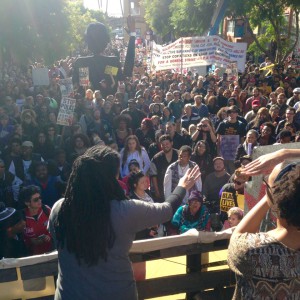
The racist murders of Mike Brown, Eric Garner, and so many others has brought to light the connections between the Civil Rights struggle of the 1950s and 1960s and the continued fight against racism, bigotry and police brutality. This Martin Luther King weekend saw militant actions throughout the Bay Area protesting against the racist system.
On the morning of Friday, January 16, around one hundred protesters held a No Business as Usual protest by occupying and shutting down two of the busiest BART stations in San Francisco’s Financial District, grinding morning commutes to big business to a halt. Two arrests were made.
Several events were held in Oakland the same day. The Anti Police Terror Project coordinated between several groups to make sure that the timing and tactics of actions throughout Oakland would not conflict with each other.
At 6 AM, protesters occupied the federal building. It was shut down for 4 and a half hours, reflecting the amount of time Mike Brown’s body lay unattended on the ground after he was shot by Ferguson cop Darren Wilson. The OPD seemed determined to shut down the protest before its intended length but the size and militancy of the crowd forced the cops to stand down.
At 11 AM, around forty people chained themselves to Oakland City Hall. By the time the protesters unchained themselves from the building a crowd of over 200 had gathered to support them.
The Alameda County Courthouse was to hold an auction on foreclosed houses- overwhelmingly the homes of people of color. The auction was canceled when protesters took over the courthouse.
The following day a speak-out was held in San Francisco’s Mission District. Around 40 people gathered as speakers from the Party for Socialism and Liberation, the ANSWER Coalition (Act Now to Stop War and End Racism), and other groups reminded listeners of the radical legacy of King, so often effaced in U.S. history books. Following the rally, PSL members took to public transit to address the people. “We want to make sure that everybody can make a connection between Dr. King’s struggle… to today’s time,” said one PSL member. “From the fight that we have been having in the past months in the streets against police brutality… Here in the Mission, we see the brutality against us. In this neighborhood we’re also being gentrified. We wanna make sure that we stand for our rights.”
Several people who happened to hear the speakers joined the contingent and rode different buses through the neighborhood to help spread the message.
On Sunday, protesters turned their attention to an Oakland Wall-Mart, placing stickers on products with the face of John Crawford III, shot and killed in a Cleveland Wall Mart as he was attempting to buy a toy gun, in a state where it is legal to carry a real gun. The stickers warned African Americans not to hold certain products if they did not want to be murdered by cops. Outside, a rally protested the business.
A local photographer and activist known to the community as David ID was in the Wall Mart, taking pictures of the stickers when he was detained and assaulted by store security. Local activist Cat Williams led the protesters outside the store to the doors of the Wall Mart to attempt to enter the store to support the photographer. Management closed the store to keep the protesters out. Eventually the cops arrested and cited David ID for disrupting a legal business, and the security guards for assault and battery.
On Monday, Oakland Mayor Libby Schaaf was awoken at 5 am as a speech by Dr. King was played loudly outside her home, and an image of King’s face was projected onto her garage door.
Later that day, a march and rally in honor of Dr. King drew six thousand people to Fruitvale BART station, site of the murder of Oscar Grant. The multi-national crowd heard performances by local youth, including Young Oakland, a group composed of children of local activists, some as young as 7 years old, who were already politicized. Young, Gifted, and Black, a community of young artists of color, and several local Hip Hop acts also performed. The massive march went from Fruitvale to other oppressed neighborhoods, such as Colosseum Village, an area undergoing gentrification, and 69 Village, one of the poorest in the city. Many youths joined the march as it passed through their neighborhoods, relating how their friends and relatives had been murdered by the police.
In San Francisco, an MLK Day march drew more than 4,000 people, with a significant ANSWER Coalition contingent.
As a reminder of the ongoing epidemic of racist police brutality, Bay Area police shot two more men of color over MLK holiday weekend. Marceleno Gonzalez was shot and critically injured in Richmond. Zaki Shinwary was shot and killed by Fremont police. Shinwary was a homeless man well known to the community as peaceful man with mental illness. The cop who killed him, Jeff Lawrence, claims Shinwary pulled a knife on him. Lawrence killed another person in 2010. Then too, the cop claimed that the victim pulled a knife on him.





